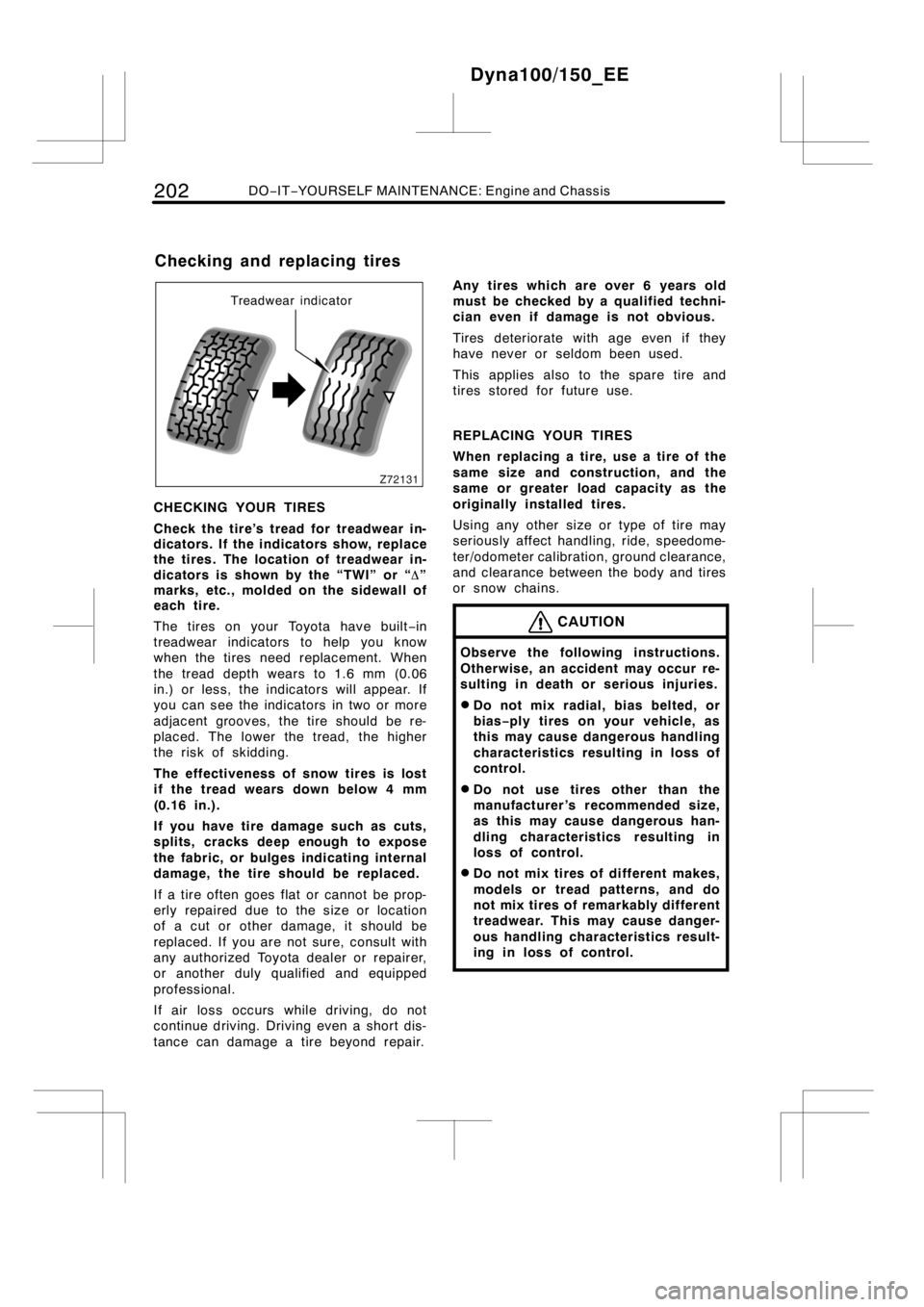Page 130 of 240

124INFORMATION BEFORE DRIVING YOUR TOYOTA
The tandem master cylinder brakesystem
is a hydraulic system with two separate
sub−systems. If either sub−system should
fail, the other will still work. However, the
pedal will be harder to press, and your
stopping distance will increase. Also, the
brake system warning light may come on.
CAUTION
Do not drive your vehicle with only a
single brake system. Have your
brakes fixed immediately.
BRAKE BOOSTER
The brake booster uses engine vacuum to
power−assist the brakes. If the engine
should quit while you are driving, you can
bringthevehicletoastopwithnormal
pedal pressure. There is enough reserved
vacuum for one or two stops—but no
more!
CAUTION
DDo not pump the brake pedal if the
engine stalls. Each push on the
pedal uses up your reserved vacu-
um.
DEven if the power assist is com-
pletely lost, the brakes will still
work. But you will have to push the
pedal hard, much harder than nor-
mal. And your braking distance will
increase.
ANTI−LOCK BRAKE SYSTEM
(with “ABS” warning light)
The anti−lock brake system is designed
to help prevent lock−up of the wheels
during a sudden braking or braking on
slippery road surfaces. This assists in
providing directional stability and steer-
ing performance of the vehicle under
these circumstances.
Effective way to press the ABS brake
pedal:
When the anti−lock brake system func-
tion is in action, you may feel the brake
pedal pulsating and hear a noise. In this
situation, to let the anti−lock brake sys-
tem work for you, just hold the brake
pedal down more firmly. Do not pump
the brake in a panic stop. This will re-
sult in reduced braking performance.
The anti−lock brake system becomes op-
erative after the vehicle has accelerated
to a speed in excess of approximately 10
km/h (6 mph). It stops operating when the
vehicle decelerates to a speed below
approximately 5 km/h (3 mph).
Depressing the brake pedal on slippery
road surfaces such as on a manhole cov-
er, a steel plate at a construction site,
joints in a bridge, etc. on a rainy day
tends to activate the anti−lock brake sys-
tem.
You may hear a click or motor sound from
the area around the front axle for a few
seconds when the engine is started or just
after the vehicle begins to move. This
means that the anti−lock brake system is
in the self−check mode, and does not indi-
cate a malfunction.
Dyna100/150_EE
Brake system
Page 149 of 240
STARTING AND DRIVING143
KDY261 models�
mm (in.)
A
375 (14.8)
B400 (15.7)
C285 (11.2)
D455 (17.9)
E170 (6.7)
F200 (7.9)
G220 (8.7)
H240 (9.4)
I400 (15.7)
J280 (11.0)
K450 (17.7)
L530 (20.9)
M585 (23.0)
N750 (29.5)
O1925 (75.8)
�: See “Model code” on page vi in the
beginning of this manual if you are not
sure of your vehicle model.
KDY261 models
TOWING BRACKETS
Toyota recommends using a Toyota genu-
ine bracket. Another bracket of matching
quality can also be used.
Dyna100/150_EE
Page 153 of 240

STARTING AND DRIVING147
DMaintain a moderate speed on high-
ways.The faster you drive, the greater
the fuel consumption. By reducing your
speed, you will cut down on fuel con-
sumption.
DKeep the front wheels in proper
alignment.Avoid hitting the curb and
slow down on rough roads. Improper
alignment not only causes faster tire
wear but also puts an extra load on
the engine, which, in turn, wastes fuel.
DKeep the bottom of your vehicle free
from mud, etc.This not only lessens
weight but also helps prevent corro-
sion.
DKeep your vehicle tuned−up and in
top shape.A dirty air cleaner, carbure-
tor out of adjustment, improper valve
clearance, dirty plugs, dirty oil and
grease, brakes not adjusted, etc. all
lower engine performance and contrib-
ute to poor fuel economy. For longer
life of all parts and lower operating
costs, keep all maintenance work on
schedule, and if you often drive under
severe conditions, see that your vehicle
receives more frequent maintenance.
CAUTION
Never turn off the engine to coast
down hills. Your power steering and
brake booster will not function with-
out the engine running. Also, the
emission control system operates
properly only when the engine is run-
ning.
Dyna100/150_EE
Page 208 of 240

202DO−IT−YOURSELF MAINTENANCE: Engine and Chassis
Treadwear indicator
CHECKING YOUR TIRES
Check the tire’s tread for treadwear in-
dicators. If the indicators show, replace
the tires. The location of treadwear in-
dicators is shown by the “TWI” or “�”
marks, etc., molded on the sidewall of
each tire.
The tires on your Toyota have built−in
treadwear indicators to help you know
when the tires need replacement. When
the tread depth wears to 1.6 mm (0.06
in.) or less, the indicators will appear. If
you can see the indicators in two or more
adjacent grooves, the tire should be re-
placed. The lower the tread, the higher
the risk of skidding.
The effectiveness of snow tires is lost
if the tread wears down below 4 mm
(0.16 in.).
If you have tire damage such as cuts,
splits, cracks deep enough to expose
the fabric, or bulges indicating internal
damage, the tire should be replaced.
If a tire often goes flat or cannot be prop-
erly repaired due to the size or location
of a cut or other damage, it should be
replaced. If you are not sure, consult with
any authorized Toyota dealer or repairer,
or another duly qualified and equipped
professional.
If air loss occurs while driving, do not
continue driving. Driving even a short dis-
tance can damage a tire beyond repair.Any tires which are over 6 years old
must be checked by a qualified techni-
cian even if damage is not obvious.
Tires deteriorate with age even if they
have never or seldom been used.
This applies also to the spare tire and
tires stored for future use.
REPLACING YOUR TIRES
When replacing a tire, use a tire of the
same size and construction, and the
same or greater load capacity as the
originally installed tires.
Using any other size or type of tire may
seriously affect handling, ride, speedome-
ter/odometer calibration, ground clearance,
and clearance between the body and tires
or snow chains.
CAUTION
Observe the following instructions.
Otherwise, an accident may occur re-
sulting in death or serious injuries.
DDo not mix radial, bias belted, or
bias−ply tires on your vehicle, as
this may cause dangerous handling
characteristics resulting in loss of
control.
DDo not use tires other than the
manufacturer ’s recommended size,
as this may cause dangerous han-
dling characteristics resulting in
loss of control.
DDo not mix tires of different makes,
models or tread patterns, and do
not mix tires of remarkably different
treadwear. This may cause danger-
ous handling characteristics result-
ing in loss of control.
Dyna100/150_EE
Checking and replacing tires
Page 231 of 240

SPECIFICATIONS225
MANUAL TRANSMISSION
Oil capacity, L (qt., Imp. qt.):
Dyna 100
�2.6 (2.7, 2.3)
Dyna 150�2.4 (2.5, 2.1)
Oil type:
Gear oil API GL−4orGL−5
Recommended oil viscosity:
SAE 75W−90
�: See “Model code” on page vi in the
beginning of this manual if you are not
sure of your vehicle model.
DIFFERENTIAL
Oil capacity, L (qt., Imp. qt.):
Dyna 100
�2.30 (2.43, 2.02)
Dyna 150�3.45 (3.65, 3.04)
Your Toyota vehicle is filled with “Toyota
Genuine Differential Gear Oil” at the
factory. Toyota recommends the use of
approved “Toyota Genuine Motor Oil”.
Another motor oil of matching quality can
also be used.
Oil type:
Standard differential
Hypoid gear oil API GL−5
Limited slip differential
Hypoid gear oil LSD API GL−5
Recommended oil viscosity:
Above−18_C(0_F)
SAE 90
Below−18_C(0_F)
SAE 80W or 80W−90
�: See “Model code” on page vi in the
beginning of this manual if you are not
sure of your vehicle model.
Please contact any authorized Toyota
dealer or repairer, or another duly quali-
fied and equipped professional, for further
details.CHASSIS LUBRICATION
Wheel bearings:
Lithium base wheel bearing grease,
NLGI No.2
Ball joints:
Molybdenum−disulfide lithium base chas-
sis grease, NLGI No.1 or No.2
Propeller shafts:
Lithium base chassis grease, NLGI No.2
BRAKES
Minimum pedal clearance when depressed
with the force of 490 N (50 kgf, 110 lbf)
with the engine running, mm (in.):
Dyna 100
�59 (2.3)
Dyna 150�51 (2.0)
Pedal free play, mm (in.):
1—6 (0.04—0.24)
Parking brake adjustment when pulled with
the force of 245 N (25 kgf, 55 lbf):
Dyna 100
�4—6 clicks
Dyna 150�6—8 clicks
Fluid type:
SAE J1703 or FMVSS No.116 DOT 3
�: See “Model code” on page vi in the
beginning of this manual if you are not
sure of your vehicle model.
STEERING
Wheel free play:
Less than 40 mm (1.6 in.)
Power steering fluid type:
Automatic transmission fluid DEXRONrII
or III
Dyna100/150_EE